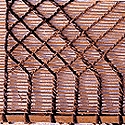The sources of natural dyes are flowers, berries, roots, rinds, wood, lichens, and the gall of plants which yield earthy colour tones of browns and buffs. Crimson and scarlet hues are obtained from the female insect, cacti and lac, which is found encrusted on the branches of some specific trees. Purple is obtained from the trumpet shell. Practitioners of this craft are also found in Delhi.
The British introduced synthetic dyes in India in the nineteenth century; the use and production of natural dyes began to decline from that point. Apart from textiles, vegetable dyes are also used to colour wood, mats, basketry, pith, ivory and leather. The names of colours prevalent were piyaji (onion skin), sumai (blue-black), basanti (yellow), asmani (sky-blue), neel (blue), badani (beige), sonali (golden), abir (red), and dhani (yellow green). Botanical Name Color Part Used
1. Acacia catechu Maroon, Brown Wood extract
2. Artocarpusintegrigolia Yellow Sawdust
3. BixaorellanaOrange Seed
4. PunicagranatumKhakiRind
5. Curcuma longa yellow Rhizome
6. Diospyros peregrinePink Fruit
7. Nyctanthesarbortristis Orange Stem
8. TagetespatulaYellow Petals
9. Acacia ArabicaPink Sawdust
10. Terminaliachebula Grey Ripe and unripe fruit
11. Rubiacardifolia Brick Red Root
12. Terminaliaarjuna Beige Bark
13. CeriopsroxburghianaSalmon Pink Bark
14. CedrelatoonaPink Sawdust
Some other key dye-sources are as follows:
– Yellow is obtained from root of the plant Morindapersicalfolia. The roots are cut and boiled along with salt; the resultant solution dyes the yarn an even shade of yellow.
– Brick-red is extracted from the leaves of the plant, Rhyncosatiasp; the leaves are ground into a paste to which lime juice is added gradually till the colour turns brick-red.
– Black is obtained from the plant, Leniagrandis by crushing the fruit. The fruit is boiled in water with salt till the solution turns gray. The yarn is then immersed and boiled in this solution till it turns gray; after being buried in clay soil for 24 hours, it turns black.
– Orange is obtained from the bark of Phyllanthusemblica, Leniagrandis and Artocarpuslakoocha. The bark of the three plants are combined in equal portions and soaked in water for 15-20 days. When the solution turns orange, the yarn is immersed for a few hours, stirred occasionally, washed and sun-dried.
– Charcoal-gray is obtained from the plants, Careyaarborea, Leniagrandis and Eugenia Jambolana when the bark of the three plants are combined in equal portions and steeped in a vat for 15-20 days. When the solution turns orange, black potters clay is added in 1:6 proportion. The yarn is soaked for 5 hours, washed and sun-dried.
– Red is obtained from Morindapersicalfolia by powdering the root and mixing it with water. The yarn, treated with mustard oil, is soaked in the solution for three days, wrung and dried in the sun.
– Red is also obtained from the seed of the plant, BixaOrellana where the seeds are soaked with turmeric paste and lime along with yarn for three days. Yarn is then boiled, washed off and dried. The process is repeated to deepen the colour.
– Dark brown is obtained from the plant, cocosmucifera from the coir, where it is boiled with a turmeric powder till it turns brown. The yarn is soaked for a few hours, wrung and sun-dried.
– Pink is obtained from Ceriopsroxsburghiana by boiling the bark with soda till the solution turns pink. Yarn is boiled in it for dyeing, after which it is washed and dried in the sun.
– Blue-black is obtained from the leaves of Indigoferasumatrana where the leaves are soaked in the water and fermented. A small amount of bamboo ash is added to it. Yarn is put in and boiled till it turns blue-black; repeated boiling deepens the colour.
The vessel type used for dyeing yarn has to be chosen carefully. Earthenware is suitable, but its porous nature results is absorption of liquid dyes. Each dye has to have a separate container. The best containers for dyeing are those made of copper or stainless steel; these materials do not react with the dye stuffs and are very hardy. Earthen vessels are ideal for scouring, washing and bleaching. Natural dye solutions like kasmi and neel can be stored in earthen containers. The size of the containers chosen depends on the amount of material to be dyed at a time.
Cost benefit analyses have shown that vegetable dyes are more economical than imported chemical dyes; catechu, the most expensive of the natural dyes is well below the cost of an equivalent synthetic dye. The average costs of natural dyes are 10-20 per cent that of synthetic dyes. If use of natural dyes increases, it will help in the revival of traditional crafts, based on indigenous sources.
Gallery
YOUR VIEWS
PRACTITIONERS: INDIA
Access 70,000+ practitioners in 2500+ crafts across India.
BIBLIOGRAPHY
10,000+ listings on arts, crafts, design, heritage, culture etc.
GLOSSARY
Rich and often unfamiliar vocabulary of crafts and textiles.
SHOP at India InCH
Needs to be written.






